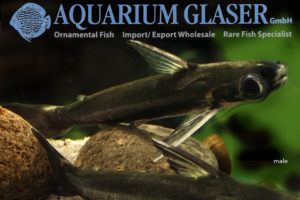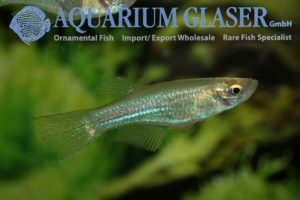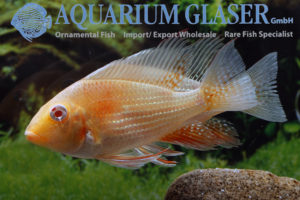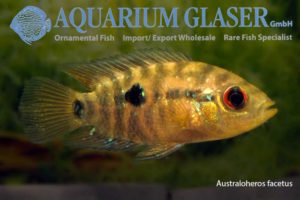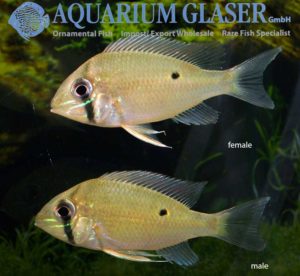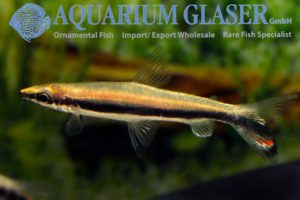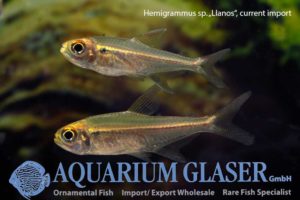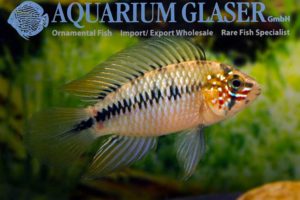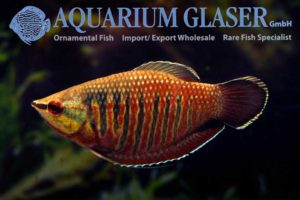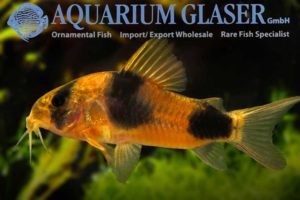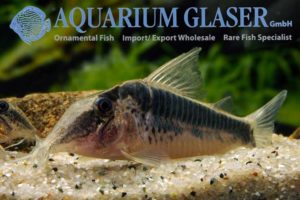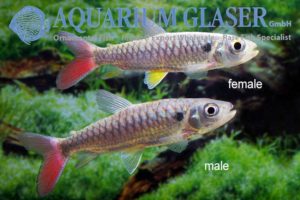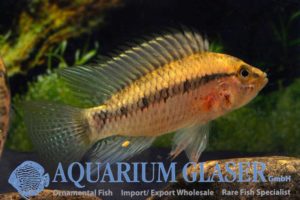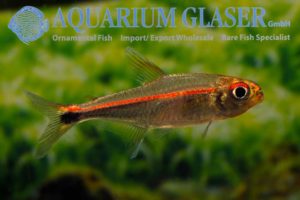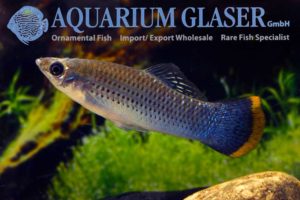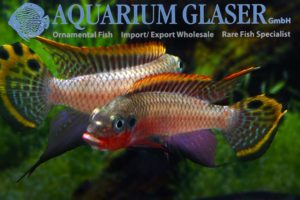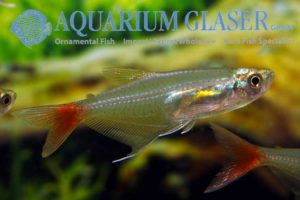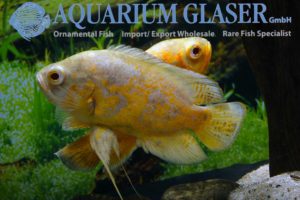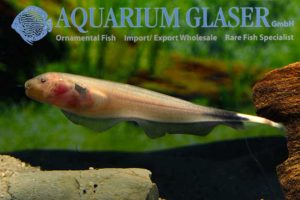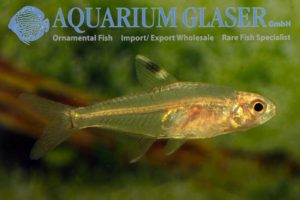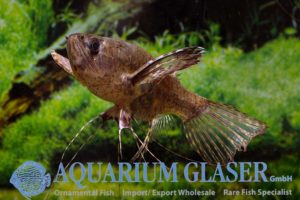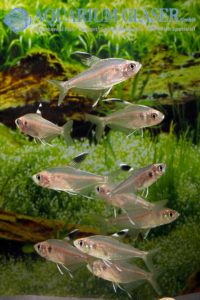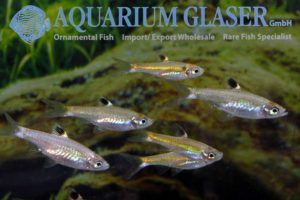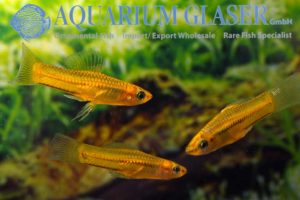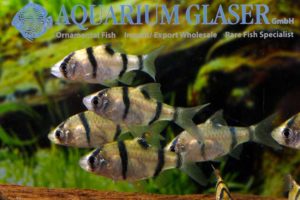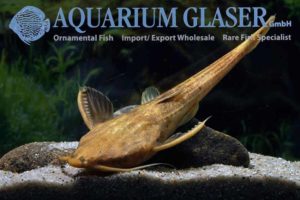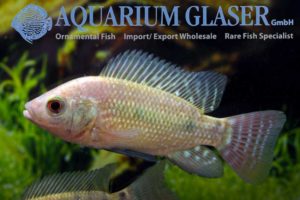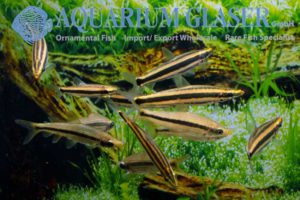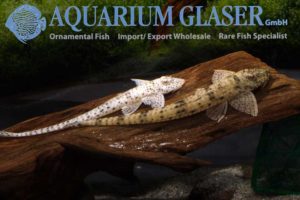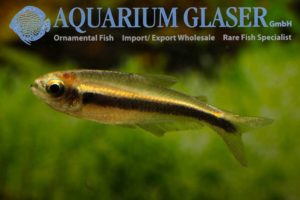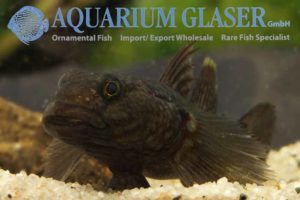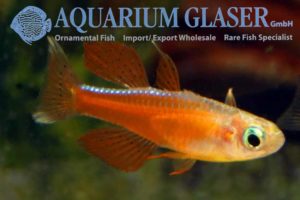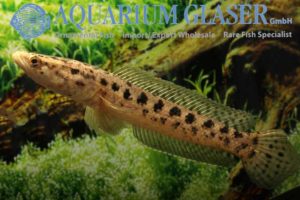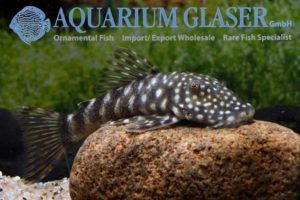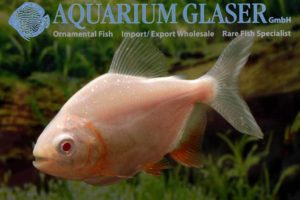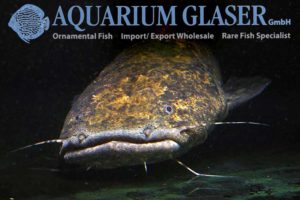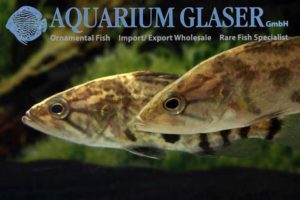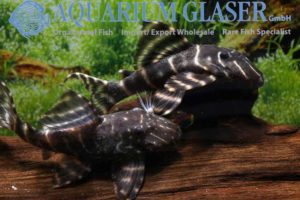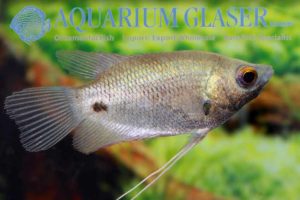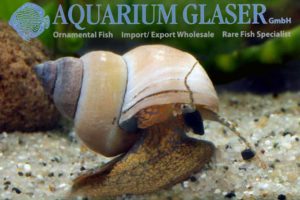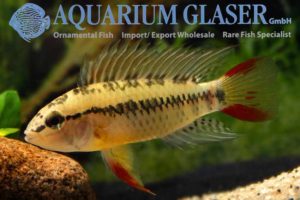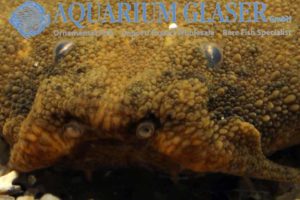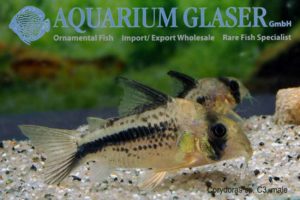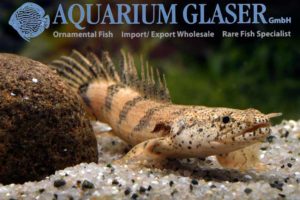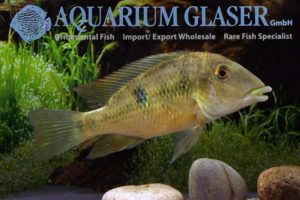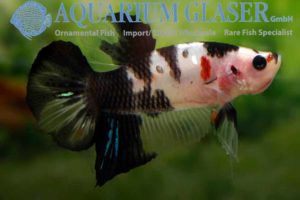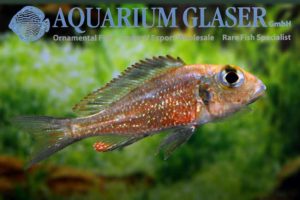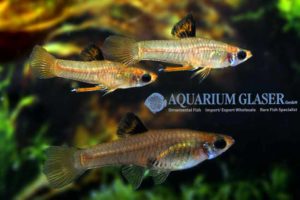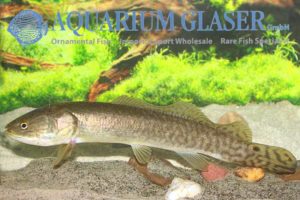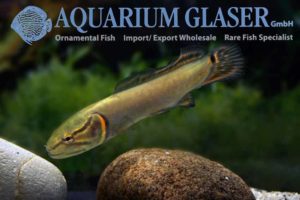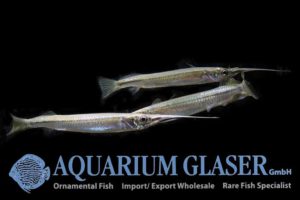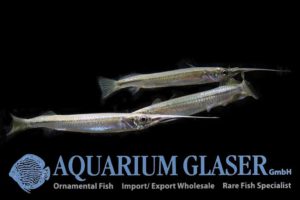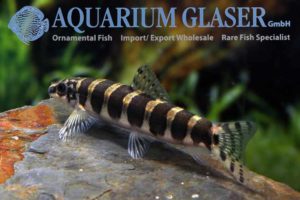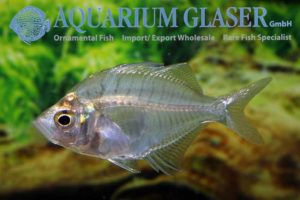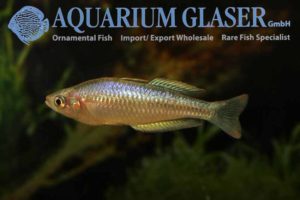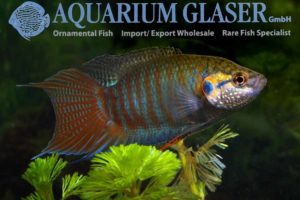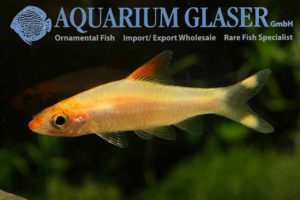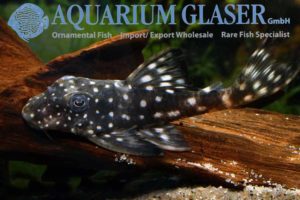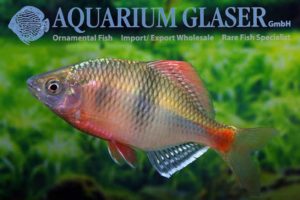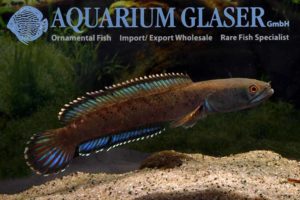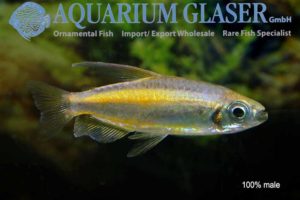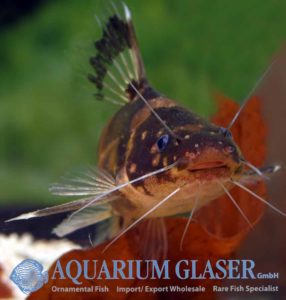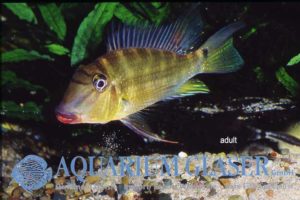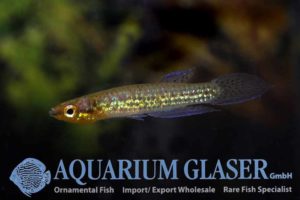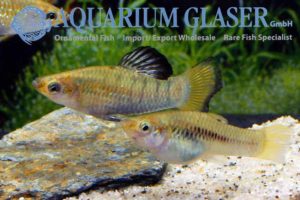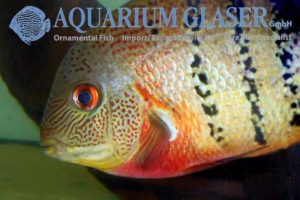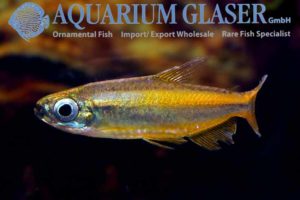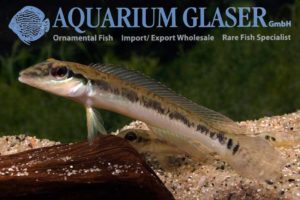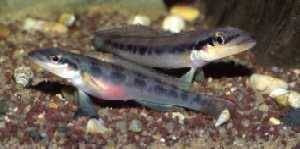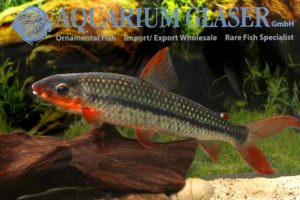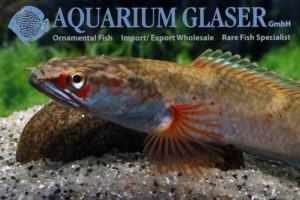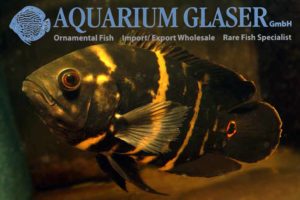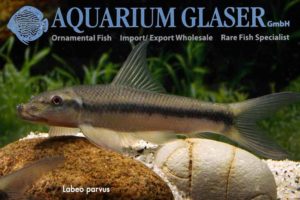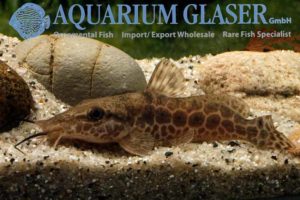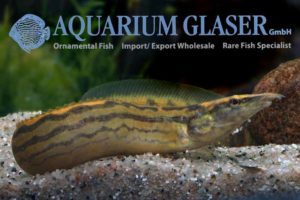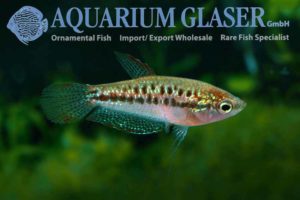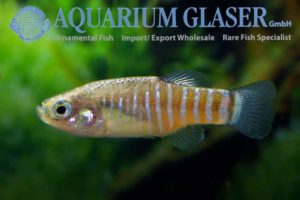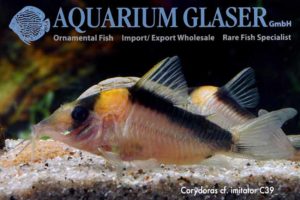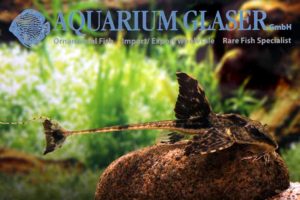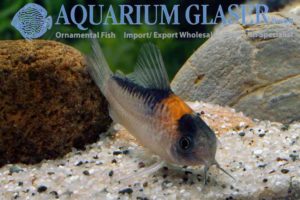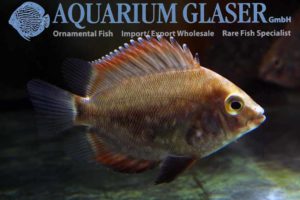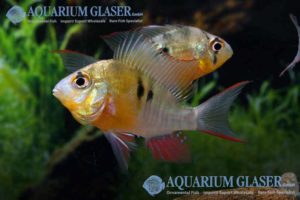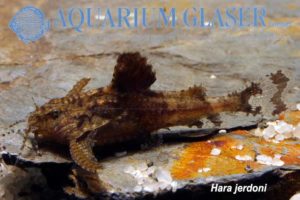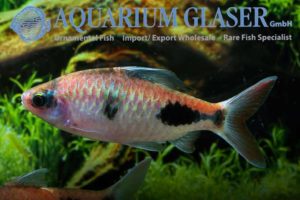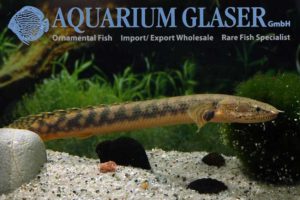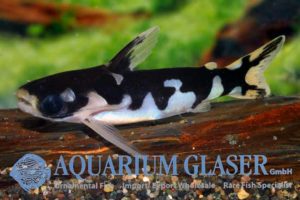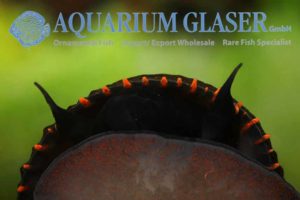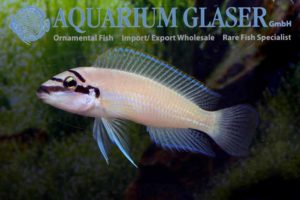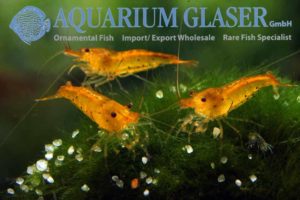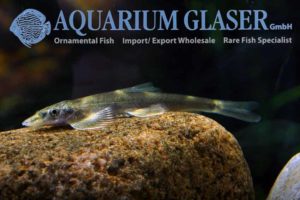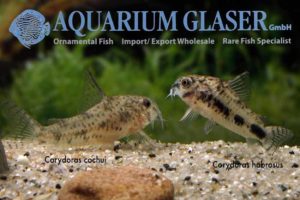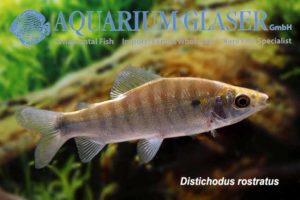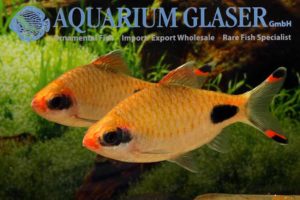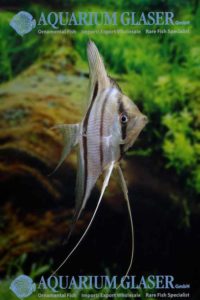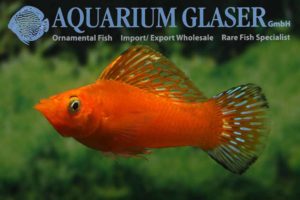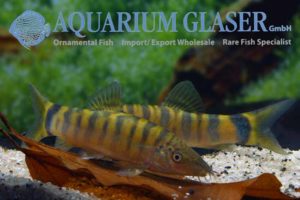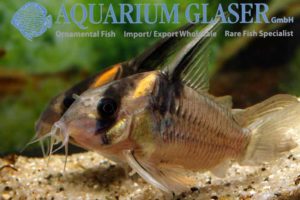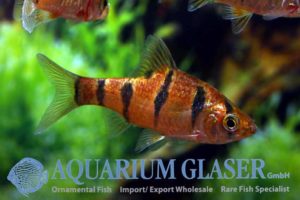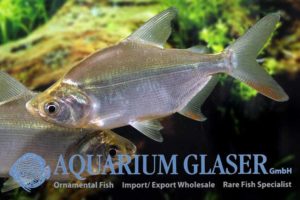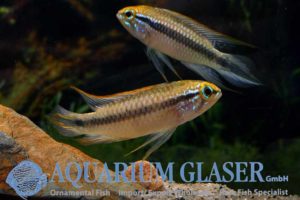It is a pity that we can offer this interesting driftwood catfish only very rarely and in small numbers. The species has a wide distribution in the Amazon and Orinoco river basins. It attains a maximum length of about 14-15 cm. Our specimens originate from Peru; here is also the type locality for the species.Two […]
Fish Archive (3089)
-
-
Procatopus aberrans
We obtained very nice glitter fishes from Nigeria: Procatopus aberrans. These lampeyes are very peaceful schooling fish that live near the water surface or at least in the upper third of the water column. In contrast to most other species of lampeye that have an iridescent blue zone in the iris, in P. aberrans the […]
-
Acarichthys heckelii Albino
We received this extraordinary and beautiful sport of Acarichthys heckelii from Taiwan. A. heckelii is a comparatively large species of cichlid that can attain over the years a total length of more than 20 cm. And the fish becomes more and more beautiful with every year! The species is very peaceful. Aquarium maintenance is comparable […]
-
Chanchitos
The very first species of cichlid that was ever kept in private aquaria was the Chanchito. At that time – in the year 1894 – the species was classified as Heros facetum. Later it was transferred to Cichlasoma, nowadays it is placed in the comparatively new genus Australoheros. Initially it was thought that there would […]
-
Biotodoma wavrini BRAZIL
There are two accepted species of Biotodoma: B. cupido and B. wavrini. Both differ basically by the position of the lateral blotch, which is positioned above the upper branch of the lateral line in B. cupido and below the upper branch of the lateral line in B. wavrini. Biotodoma cupido is widely distrubuted in South […]
-
Nannostomus eques and N. unifasciatus: two odd birds
Among the pencil fishes, two species are very conspicuous due to their oblique swimming style: Nannostomus eques and N. unifasciatus. The two species often appear intermixed in the wild. As a result they are often found as bycatch in importations of the other species. These „hockeysticks“ are very nice fishes. Like all other pecilfishes they […]
-
Hemigrammus sp. Llanos
Again we were able to import a species of tetra new to science from Peru or at least we are not able to assign the fish to any described species of the region. They wre sent under the name Hemigrammus sp. „Llanos“ (another fantasy-name for that species in the trade is Hemigrammus „Carlitos“). Sadly we […]
-
Apistogramma borellii WILD
We received beautiful, wild collected specimens of this dwarf cichlid from Paraguay. The species belongs to the members of the genus Apistogramma that are kept and bred in aquaria for decades already. The splendid males become almost double as large as the females. The peaceful and pretty species can be kept during the summer months […]
-
Sphaerichthys vaillanti
Finally we can offer again the most beautiful species of Chocolate Gourami: Sphaerichtys vaillanti. The species originates from the Kapuas basin in the Indonesian part of the island of Borneo. S. vaillanti is not only the most beautiful, but also the hardiest species of all Chocolate Gouramis. However, it is nevertheless by no means an […]
-
Corydoras weitzmani WILD
We received a shipment of beautiful, fully grown wild collected Corydoras weitzmani from Peru. The species is extremely rare in the trade. Our fish have a perfect condition! There were strong doubts not long ago that the species might not exist at all or that it has been extinct. This was due to the fact […]
-
Corydoras cf. semiaquilus Alto Blanco
The number of Corydoras species can hardly be overlooked anymore. There are 218 species described scientifically, 159 C-numbers, and 122 CW-numbers currently known. However, some very distinct forms can be easily separated from this mass and for sure a new genus must be erected for these once a revision of the complete genus is made. […]
-
Chalceus erythrurus
We received bred specimens of this beautiful large tetra – the real one, with bright yellow ventral fins. Currently the fish are 7-9 cm long. The members of the genus Chalceus can be best compared with our native species of trout. Like these Chalceus prefer to feed on insects etc. that fall on the water […]
-
Apistogramma sp. Nanay
When we unpacked these large, fully grown Apistigramma from Peru we thought initially: wow, that kind of Apistogramma was never here before! The species-specific features of the fish are: stripes on the underside of the belly, an orange colored spot on the basis of the pecoral fin, a more or less clearly recognizeable orange zone […]
-
Hemigrammus rubrostriatus
Recently we obtained two specimens of a small tetra as a sample from Peru. The supplier asked us for the determination of the species. The animals looked somewhat familiar to us. Didn´t we get such fish not from Colombia formerly? A short e-mail correspondence with the tetra expert Martin Hoffmann solved the riddle: this species […]
-
Poecilia mexicana CAMPECHE
The wild mollys from Central America were always and will stay an enigma for generations of scientists. In each brook the fish look somewhat different. And as if that would not be eough, they also have within every population different shaped males: small and slender early ripe male, large and deep bodies late ripe males […]
-
Pelvicachromis taeniatus NIGERIA RED
Dwarf cichlids from western Africa are bit out of fashion currently. Nobody knows a real good reason why, as usual in fashion. However, anyone who sees the gorgeous Pelvicachromis taeniatus “Nigeria Red” we can offer right now as German bred ones, will become crazy for a new fashion immediately and place a tank with these […]
-
Prionobrama filigera
The Red Tailed Glass Tetra (Prionobrama filigera) was already known to our grandfathers in the hobby. It was imported as early as 1931. Initially the species came from South America. Here it is far spread over the Amazon basin in Bolivia, Brazil, Colombia, Ecuador, and Peru. However, hardly ever a wild collected specimen can be […]
-
Astronotus ocellatus Oscar Lemon
If one likes artifical sports or not is a matter of taste. But these sports are in any case interesting, because they show the genetic potential of a species. So finally men-made sports give hints even for the scientists working exlusively in the field how to distinguish local populations from different species. The Lemon Oscar […]
-
Apteronotus albifrons WHITE
The Black Ghost (Apteronotus albifrons) is a most beautiful and elegant knifefish from South America. The species has a very wide distribution, wild collected specimens most often come from the Orinoco (Colombia and Venezuela). However, the up to 50 cm long species is also bred since many years in Indonesia on a regular basis. The […]
-
Hyphessobrycon dorsalis (formerly determined as H. minor)
The scientific description of a new species bases usually on dead specimens that are stored in a museum. Very often it is unknown how the living organism looks. Especially in small species of freshwater fish – the animals most often kept in aquaria – this method very often leads to mis-identifications, for the preserved specimens […]
-
Pantodon buchholzi
If there would be a Top Ten ranking on the most extraordinary species of freshwater fish of the world, this species would appear for sure: the African Butterfly fish, Pantodon buchholzi. We have this strange animal – it becomes about 10 cm long – always in stock. Our specimens originate from Nigeria. Pantodon can really […]
-
Hyphessobrycon copelandi
This tetra is the most gracile of the so called „rosy tetras“. The rosy tetras are a specious clade of tetras that share the following characters: a comparatively deep body, a humeral spot (the spot on the shoulder), long fins in males and in females an obvious white-black-white marking in the dorsal fin. The phantom […]
-
Brevibora dorsiocellata
The Eyespot Rasbora, Brevibora dorsiocellata, is a well known, classical aquarium fish. Sadly the species became almost forgotten in the 1980ies. It was Mr. Takashi Amano from Japan who was responsible for the comeback of the species. Amano often used a large school of B. dorsiocellata for his stylish tanks – a real eyecatcher! The […]
-
Xiphophorus pygmaeus
Males of the Pygmy Swordtail (Xiphophorus pygmaeus) become only about 3.5 cm long. So they bear an objectively correct name. The females become a bit larger, but even the dames are very small fshes, compared with the commonly known Swordtail, Xiphophorus hellerii. A very nice, yellow sport of the Pygmy Swordtail exists. It is also […]
-
Puntigrus partipentazona
The tiger barbs were placed until recently in the catch-all genera Barbus, Puntius, or Systomus. The long time overdue splitting of the Asian small barbs led to a placement of the deep-bodied tiger barbs in a genus on their own, Puntigrus. The type species of the genus is P. partipentazona. We were able to import […]
-
Xyliphius cf. lepturus
For the first time ever we could import this extremely odd species of banjo catfish. The eyes are reduced to very small, black spots. This is a hint either to a strictly nocturnal way of life or that the fish live burried. We obtained our specimens from Venezuela. Most probably they belong to the species […]
-
Oreochromis niloticus
There is most probably no other species of fish that is so much loved on the one hand and so much hated on the other: the Nile Mouthbrooder, often called simply „Tilapia“. As a food fish this omnivorous species – plant matter forms a large part of the diet – can be cultured even in […]
-
Pseudanos winterbottomi and Anostomus ternetzi
We received this nice headstander in the past years only very occasionally in single specimens as bycatch from Venezuela. Most often the specimens were intermixed in shipments of Anostomus ternetzi or Pseudanos trimaculatus. Finally we were able to import directly a number of the beautiful species. We have two sizes in stock, young ones (4-6 […]
-
Pseudoloricaria sp.
Yesterday we introduced to you a brandnew „Hemiloricaria“ and mentioned that the determination of the species is very doubtful. Now we were able to take pictures of the ventral side of the animals and the enigma was solved: these fish are no Hemiloricaria at all, but members of the genus Pseudoloricaria! In Pseudoloricaria the lower […]
-
Moenkhausia phaeonota
This small (about 4 cm) species of tetra originates from the Mato Grosso region in Brazil. It is the only species of Moenkhausia with such a colour pattern. So already in the original scientific description (1979) the author mentioned that this generic placement can be only provisionally. This makeshift stands until today… Sadly this charming […]
-
Papuligobius uniporus
For the first time ever we were able to import this interesting freshwater-goby from Vietnam. The species and the genus have been described only in 2003. Papuligobius uniporus attains a maximum length of about 7.5 cm. There exists only one other species in the genus, namely P. ocellatus, which has been described already in 1937, […]
-
Pseudomugil sp. paskai Red-Neon has been described scientifically
Pseudomugil sp. “paskai Red-Neon” has been imported for the first time in 2012 and is for sure one of the most spectacular discoveries of aquarium fish in the millenium. Since the first importation the fish has been well established in the hobby and proofed as a beautiful, peaceful, and hardy ornamental fish. However, there was […]
-
Channa panaw
It was only in 1998 that this comparatively small species of snakehead was described as a separate species on its own. Before this the fish were thought to represent a geographical variety of the very far spread species Channa punctata. Channa panaw has a pretty far distribution in Burma, where it inhabits the area around […]
-
Chaetostoma L455 Tiger
After quite a long time we were able again to import the pretty Chaetostoma sp. L455 Tiger from Peru. Generally speaking, species belonging to Chaetostoma do not attract by nice coloration, but this species is really an exception from the rule. This is true at least for the males, the females do not have the […]
-
Piaractus brachypomus ALBINO
Almost exactly four years ago we were able to import a pair of albinotic Pacus from Colombia (see http://www.aquariumglaser.de/en/archiv.php?news_id=470). At the time the import was quite spectacular. However, nowadays the fish are offered from southeast Asia already. These animals are by far more handy, because they are only 4-6 cm long, compared with the 16-20 […]
-
Cephalosilurus apurensis
A face that can be loved only by a mother? Far from that! Among the fans of large, predatory catfish Cephalosilurus apurensis is a much sought after species! The fish attains a maximum length of about 30 cm and appears endemic in Venezuela (this means the distribution is restricted to that country). We were able […]
-
Coreoperca cf. liui
For the first time ever we obtained this interesting freshwater perch from southern China. The genera Coreoperca and Siniperca contain altogether 14 species. They are thought to be close relatives of the groupers (Serranidae), but are placed in a family on their own, the Sinipercidae. The fish were shipped under the name of Coreoperca kawamebari; […]
-
Panaqolus albivermis, L204
Currently we have all sizes of L204 in stock, among them fully grown specimens. They show impressively how different the individual pattern in loricariids can be. We have specimens with small spots, species-specificly banded animals and all thinkable intergrades. The photos were made from four fully grown specimens in our fishhouse, size-class 11-14 cm. Pictures […]
-
Osphronemus laticlavius
We received the very rare red finned giant gourami in two sizes, 5-7 cm (code 440923 on our stocklist) and 12-15 cm (code 440925). The species attains a similar size as the common giant gourami, eg 60 cm. O. laticlavius originates from Borneo. Fertile males develop a very prominent head structure and deep red fins […]
-
Filopaludina (Siamopaludina) martensi cambodjensis
For the first time ever we were able to import this pretty snail from Thailand. It is a typical viviparid snail that shares all the characters of the family: these animal breath via gills, not via lungs, and thus use the dissolved oxygen in the water for breathing, like fish do; there are males and […]
-
Apistogramma macmasteri Tame
It was back in 1996 when Uwe Werner presented in the Aqualog South American Cichlids II a dwarf cichlid under this name. The city and municipality of Tame are located in Colombia in the Arauca Department at the Rio Arauca. Here the unusual Apistogramma macmasteri have been collected. Sadly it became soon after lost for […]
-
Amaralia hypsiura
Banjo catfishes are subjects for lovers of calm fishes. One could also ay: for lovers of phlegmatic fishes. These creatures will not swim even an inch if it is not absolutely necessary. On the other hand they are really odd looking creatures. The strangest looking of this assemblage of strange-looking animals is without any doubt […]
-
Corydoras sp. C3
Shipments declared as “Corydoras deckeri” from Colombia are always subject of surprise. There is no scientifically described species C. deckeri, this name is pure fantasy. So sometimes Corydoras axelrodi, sometimes C. loxozonus, and sometimes the scientifically undescribed C. sp. C3 are shipped under that flag. This time we received the pretty C3. However, all three […]
-
Polypterus endlicherii bred
This large species – sexual maturity is reached at about 40 cm length, but the species can grow as big as 70 cm – originates from Africa. Her it has a fairly wide distribution, from the Nile to the Niger. But it is difficult to catch, so the fish were rather high in prize. Now […]
-
Geophagus pellegrini
Sadly we can offer this beautiful mouthbrooding cichlid from Colombia only very rarely; the last time we had it in stock was 5 years ago. Now we had the opportunity to import this animal. They originate from the Chocó region in Colombia, located in the West of the country. The main river of the Chocó […]
-
Betta splendens Pla Kat Koi
Once more we were able to import an assortment of this extraordinary and extremely rare sport f fighting fish. The term “pla kat” is used for the short finned fish. We present to you in this newsletter some specimens of the current import (among them an extremely rare albino), for more pictures and informations, please […]
-
Callochromis macrops
Is this a species of Geophagus from Lake Tanganyika? One can get these thoughts when seeing Callochromis macrops the first time. However, this mouthbrooding sand cichlids belong to the large Haplochromis-relationship. The ability to change the coloration is breathtaking in this species. The same individual that right now looked silvery or blotched will become in […]
-
Xenophallus umbratilis
Sadly this very attractive livebearer can be offered only very rarely. The species is also known as the “Golden Teddy” among hobbyists. Males become about 4 cm, females up to 6 cm long. Initially the species is native in Costa Rica, but the fish we have in stock now are German bred ones. For our […]
-
Amia calva
Four specimens – gorgeous animals, which are 15 – 20 cm long – of this “living fossil” reached us recently. Once there was a time when relatives of this species lived allmost all over the World, even in Europe several species existed. These creatures were already existent when the dinosaurs walked around. However, nowadays only […]
-
Amia calva
Finally – we tried many years without any success – we managed to import a good number of this “living fossil” from the USA. Once there was a time when relatives of this species lived allmost all over the World, even in Europe several species existed. These creatures were already existent when the dinosaurs walked […]
-
Zenarchopterus dunckeri
There are 20 valid species in the genus Zenarchopterus, all of them occuring along the Pacific coast of tropical Asia. The maximum length of Zenarchopterus is around 15 cm, only a few species are recorded to reach a greater length, most of them stay smaller. The species are very similar to each other and the […]
-
Zenarchopterus dunckeri
The wonderful, large halfbeaks of the genus Zenarchopterus are only very rarely offered, because the animals are very shy during the acclimatisation. When they panic they often hurt themselves seriously. So we are very proud that we were able to import successfully a small group of fully grown specimens of the species Zenarchopterus dunckeri from […]
-
Serpenticobitis cingulata
We received this beautiful loach from Thailand. The genus Serpenticobitis contains only three species, all of which were described in 1997/98. They differ mainly in their coloration: in S. octozona (the type species, comes from Laos and Cambodia) the light spaces between the dark bands are very narrow, in S. zonata (Laos) much wider. Whereas […]
-
Parambassis siamensis
Formerly this species of glass perch was the most common found in the trade. It has a very wide distribution through Thailand, Vietnam, Cambodia, and Laos. However, Parambassis siamensis was most often mis-identified and traded under the name “Chanda wolfi”. P. siamensis is very similar to the Indian species P. ranga. Both are distinguished by […]
-
Melanotaenia pygmaea
For the first time ever we obtained this charming rainbowfish from a breeder. The specific name “pygmaea” refers to a small body size. In fact our fish are full in coloration. They are currently about 4 cm long (total length). According to literature the maximum lengthin males is about 7 cm, whereas females always stay […]
-
Macropodus opercularis WILD
The Paradise fish was the first exotic species (leaving the goldfish aside) of ornamental fish that reached Europe. This was back in 1869. Wild collected specimens are hardly ever available. We now could import wild caughts of that fantastic aquarium fish from China via Hongkong. The black throat with white spots that is shown by […]
-
Sahyadria denisonii GOLD
In any species of fish that is bred in large numbers sooner or later sports appear. This now happened also in the gorgeous Indian Redline Torpedo Shark, Sahyadria denisonii. Besides “normal” bred ones Indonesian breeders now offer a golden sport of that fish. It is obvious that the individual fish differ a lot in the […]
-
L102, Hypancistrus inspector
Once more we could import the beautiful Snowball Pleco (Hypancistrus inspector, L102) from the Rio Negro in Brazil. The species can attain a maximum length of about 18-20 cm and is one of the largest species in Hypancistrus. However, our fish in stock are currently only 6-12 cm long. In the most current import we […]
-
Acheilognathus macropterus – Giant Bitterling
For the first time ever we obtained this splendid bitterling via Hongkong. The species is said to become more than 25 cm long and this would make it the largest species of bitterling at all! However, our fish are currently 6-8 cm long and in full colour, so maybe more than one species is involved, […]
-
Channa sp. True Blue
We could import this extreme beautiful species of snakehead in very small numbers from the north of India. The True Blue is obviously a close relative of C. stewartii; both attain a length of about 25 cm. The two photographed specimens have a quite different pattern. Most probably the smaller specimen is a female (it […]
-
Phenacogrammus aurantiacus II
Last week we presented to you our freshly imported Golden Congo Tetras (Phenacogrammus aurantiacus). The slight fin damages of the fish are as good as cured completely now. Many of our customers now ask for “safely” sexed specimens. All we can say to that is: of course large, dominant males are easy to recognize. But […]
-
Pseudomystus heokhuii
This pretty species of bumblebee catfish was discovered and scientifically described only in 2008. We could import the species now for the first time ever. P. heokhuii becomes about 6 cm long and is a very peaceful species of catfish. Despite the fact that Pseudomystus heokhuii inhabits extreme blackwater habitats in the wild, where the […]
-
Satanoperca rhynchitis
We received beautiful German bred specimens of this rare eartheater. Until the species has been described in 2012 under the name of Satanoperca rhynchitis it was known in the hobby as Satanoperca sp. “Red Lips”. The fish develop the pretty red lips only when adult, so we add a picture of an adult specimen to […]
-
Aphyoplatys duboisi
It has been many, many years ago since we were able to import this charming dwarf killi the last time. Currently the fish are about 1.5-2 cm long, maximum length reported for Aphyoplatys duboisi is only 2.5 cm. The fish have been collected in the surroundings of Brazzaville. Despite their very small size these fish […]
-
Limia Special
Poecilia (Limia) perugiae The Dominican Republic is the destination for millions of tourists each year. But it is only known by few people that also beautiful freshwater fish exist there. One of the prettiest of them is Poecilia perugiae. We can offer this beautiful livebearer on a quite regular basis, but have usually only few […]
-
Heros sp. Curare
For the first time ever we were able to import this splendid species of Heros. Reportedly the animals have been collected in the Rio Curare (name). However, we haven´t eard of a Rio Curare so far. We think the fish have been collected in the Rio Ventuari. The fish are extremely colorful; all other features […]
-
Phenacogrammus aurantiacus
Only yesterday reached us a phantastic import from the Congo that contained several top rarities from the surroundings of Brazzaville, for example Distichodus teugelsi, D. sp. Red Stripe, Aphyoplatys duboisi, and many catfishes. We will present all these species to you in the next weeks, but one small sensation should be shown here right now, […]
-
Teleocichla centrarchus
Teleocichla are small cichlids from Brazil. They love comparatively strong current. The genus is a close relative of the pike cichlids (Crenicichla). The genus teleocichla has been discovered only late, in 1988; currently 18 different species are known, 10 of them are still undescribed scientifically. Genus type is T. centrachus; we can offer now once […]
-
Teleocichla centrarchus
Teleocichla centrachus from Rio Xingu probably is the most imported Teleocichla. In addition, it is the type species of this kind. As the males have a maximum length of approx. 10cm, you can certainly still call them dwarf cichlids. The females, being mostly only 8cm maximum, are a little smaller and rather soon show a […]
-
Leporinus brunneus Ventuari
Once more we were able to import this beautiful, large tetra from Venezuela. The fish can reach a maximum size of 25-30 cm. It can be found in the basins of Orinoco river and the rio Negro. The coloration of the fish is quite variable, depending on the origin. The orange spot under the eye […]
-
Channa sp. Fire & Ice
Once more we can offer this small and colourful snakehead. The species attains a maximum length of only 12-15 cm. The fish belongs to an so far scientifically undescribed species which is found in the region of the Burmese-Thai border. The beautiful species belongs to the closer relationship of Channa gachua. Like this species, it […]
-
Astronotus cf. crassipinnis
There is no other genus of larger cichlids from South America that is so poorly understood as the oscars (Astronotus). Currently only two species are widely accepted, namely A. ocellatus and A. crassipinnis. However, there do exist a lot of more species as can be easily observed with the bare eye. We were able in […]
-
Labeo parvus and L. barbatus
Algae eaters from Africa? Hardly ever are such fish available in the trade, despite the fact that there does a high number of species exist. Currently we have two species of African Labeo in stock. There is no doubt that Labeo parvus is the better algae eater of the two. It looks astonishing similar to […]
-
Auchenoglanis wittei
Until recently only two species of Auchenoglanis were commonly accepted, namely A. biscutatus and A. occidentalis. This changed with the revision of Retzer (2010), who recognizes eight different species. In the Congo the genus is represented by Auchenoglanis wittei, which can be easily identified by the “reticulated giraffe”-pattern of the body. However, this is the […]
-
Mastacembelus tinwini
Sadly we can offer this beautiful species of spiny eel only very rarely. The species has been described scientifically quite recently. It is a close relative of the common spiny eel of Asia, Mastacembelus armatus. Like that species, M. tinwini reaches a length of about 40 cm. Other fish are ignored if they are large […]
-
Trichopsis pumila
The Sparkling Gourami (Trichopsis pumila) is one of the smallest species of anabantoid at all – and one of the prettiest! The charming and totally peaceful species attains a maximum length of only 3-4 cm and is perfectly suitable for an community tank with other tiny, peaceful species of fish. The tank should be well […]
-
Aphanius farsicus
Currently we have some fish in stock that are available every year only for a few weeks. These species are kept and bred by the hobbyists in a very special way, the “balcony aquarium hobby”. The species kept in that manner are specialized in water temperatures that differ clearly between day and night and they […]
-
Corydoras imitator and C39
Currently we receive imports of “Corydoras imitator” from the upper Rio Negro in Brazil. If one takes a close look on the fish it becomes obvious that hardly two specimens look really identical. Coloration is variable, as well is the shape of the body. Some fish, for sure, are unplanned by-catches, for example C. incolicana […]
-
Loricaria sp. Rio Atabapo
Finally we are able again to offer bred specimens of this Loricaria. It is the most beautiful species of the genus. Like all its relatives it is a mouthbrooding species. The males carry the egg-clusters along with them. For this they use the lower lip, which becomes much bigger during the breeding season, until the […]
-
Corydoras njisseni
Finally we were able to import again the smallest and cutest of all the different “orange blotch” Corydoras from the Rio Negro: Corydoras nijsseni. This fish is a close relative of C. elegans. The coloration, which is the same in Corydoras adolfoi, C. duplicareus, C. imitator, C. sp. C39, C. serratus, and serveral other species, […]
-
Uaru amphiacanthoides, bred
Only very view species of cichlid have such a drastic change of coloration during growing like Uaru amphiacanthoides. We can offer currently very nice bred ones. Uaru are close relatives of the discus. Like discus they wear the dorsal fin almost always spread. However, Uaru are mainly vegetarians. For more information and pictures of adult […]
-
Mikrogeophagus altispinosus
The Bolivian Ram, Mikrogeophagus altispinosus, is by far less popular than its well known cousin from Venezuela, the Common Ram (M. ramirezi). Maybe this is due to the fact that the Bolivian is traded almost exclusively as bred ones, because there are no commercial exports from the area where the species occurs naturally? But the […]
-
Hara jerdoni
Currently is the high season for the interesting moth cats (Hara). These catfish occur in India, Burma, and Thailand. The species are very difficult to tell apart, in many cases it is simply impossible in live animals. There are a few species that can be determined by a filament on the caudal fin, but most […]
-
Dawkinsia cf. exclamatio
We were able to import another splendid large barb from India. It belongs to the species Dawkinsia (formerly Puntius or Barbus) exclamatio or a closely related, scientifically still undescribed species. The fish are currently 8-9 cm long and are in breeding condition. Both sexes show now a red back, the males also develop “spawning pimples” […]
-
Polypterus retropinnis
After quite a long time we were able now to import again one of the smallest species of Polypterus, namely Polypterus retropinnis from the Congo. This bichir has been thought to represent an undescribed species for a while, but then it was found that it has been confused with the only recently described species Polypterus […]
-
Tatia musaica (= Cenromochlus orca)
We were able to import again a small number of the most attractive of all driftwood-catfishes: Tatia musaica, the ninja-tatia. This beautiful fish attains a maximum length of about 5-6 cm. Like all the driftwood catfishes this species also has an internal fertilization. The male´s anal fin is modified for that purpose, similar as it […]
-
Paludomus loricatus
Among the most unusual species of freshwater snail is the Red Spotted Bella Snail, Paludomus loricatus, from Sri Lanka. The eyes of this snail are very attractive coloured, brightly red-orange. Around the mantle are numerous folds of the same colour. We are informed on the biology of P. loricatus by Starmühlner (Starmühlner, F. (1974): The […]
-
Chalinochromis brichardi
This pretty cichlid from Lake Tanganyika is only very, very occasionally found in the trade. This is hard to understand. Despite the fact that the coloration is rather simple, the fish are quite conspicuous. Keeping and breeding can be compared with the closely related genus Julidochromis. Maximum size of Chalinochromis brichardi is about 12 cm. […]
-
Neocaridina sp. Golden Tiger
This is the latest star in our stocklist: are real pretty little creature! The animals are German bred ones, available in very limited numbers only! For our customers: the shrimps have code 485472 on our stocklist. Please note that we exclusively supply the wholesale trade. Text & photos: Frank Schäfer
-
Pseudohomaloptera sp – A new dwarfish hillstream loach from Vietnam
For the first time ever we obtained this hillstream loach from Vietnam. The determination is pretty tricky. All features visible in live fish (position of the dorsal fin, coloration, position of the anus) lead to the genus Pseudohomaloptera, which currently includes six described species: Pseudohomaloptera tatereganii (Popta 1905), P. sexmaculata (Fowler 1934), P. leonardi (Hora […]
-
Corydoras cochui and C. habrosus
These dwarf species of Corydoras have been confused quite a long time. Both species attain a maximum length of about 3 cm and a very cute, nice and lively aquarium fish. If one has the opportunity to see live specimens of both species together it may be hard to understand how they may be confused; […]
-
Distichodus rostratus, D. engycephalus and D. brevipinnis from Nigeria
Last week we received for the first time an unsusal shipment containing Distichodus unknown to us from Nigeria. The first determination was that they belonged to the species Distichodus rostratus. This species attains a maximum length of about 70 cm. We thought initially that all or fish would belong to the very same species, despite […]
-
Dawkinsia assimilis
In South India a group of barbs exists that was formerly placed either in Barbus or in Puntius and which is now placed in the only recently (2012) erected genus Dawkinsia. In Dawkinsia a phenomenon exists that aquarists are used to know for example from cichlids from Lake Malawi: every new collecting site reveals a […]
-
Pterophyllum scalare WILD Rio Xingu
We received very nice wild collected angels from the Rio Xingu in Brazil. The animals are “real” P. scalare with pointed snouts. They will most probably grow up to impressive, large fish. For our customers: the fish have code 699853 on our stocklist. Please note that we exclusively supply the wholesale trade. Available in limited […]
-
Poecilia velifera NEON ORANGE
We received this new sport of Molly from Southeast Asia. It was offered under the name of “Neon Orange”. The special feature of the new sport is the reflecting border of the scales on the back in front of the dorsal fin. This is more obvious in females than in males. In males. the reflecting […]
-
Yasuhikotakia sp New Cambodian Tiger
Formerly all the deep bodies loaches from Indochina were placed in the catch-all genus Botia. This generic name should be used now only for the Indian species, while the species from Laos, Thailand, Cambodia, and Vietnam are placed in Ambastia, Syncrossus, and Yasuhikotakia. We now were able to import for the first time ever a […]
-
Corydoras CW 45 Lessex
We can currently offer a very limited number of a new variety of the rare species CW 45. The fish was named “Lessex” by the exporter. We adopted that name, but we don´t know the meaning. CW 45 is a deep bodied species, similar to C. armatus. It differs from the latter by the bright […]
-
Desmopuntius hexazona wild
The banded barbs from Southeast Asia were always matters of interest, both of aquarists and scientists. The generic position of the species was unclear for quite a long time: they were placed in Barbus, Puntius, or Systomus. But t seems that the problems has been solved finally. The elongated species are now placed in the […]
-
Citharinus citharus
We recieved Moonfish, Citharinus citharus, from Nigeria. This tetra is only very rarely available. The large species can attain a maximum length of about 60 cm and 7 kg of weight. In its home countries, the moonfish is a much estimated food fish. But the species is also very interesting in respect of aquarium keeping. […]
-
Apistogramma agassizii Tefé II and A. geisleri
We received very nice wild ciollected specimens of this variety of A. agassizii. One must not confuse these fish with the variety known as “Tefé I” (see http://www.aquariumglaser.de/en/fish-archive/dwarfcichlids-en/Apistogramma_agassizii_Tefe_en/), which is distinguished from all other varieties of A. agassizii by the additional rows of zigzag-bands on the belly. The variety “Tefé II” is characterized by a […]
- « Previous Page
- 1
- …
- 15
- 16
- 17
- 18
- 19
- …
- 31
- Next Page »





